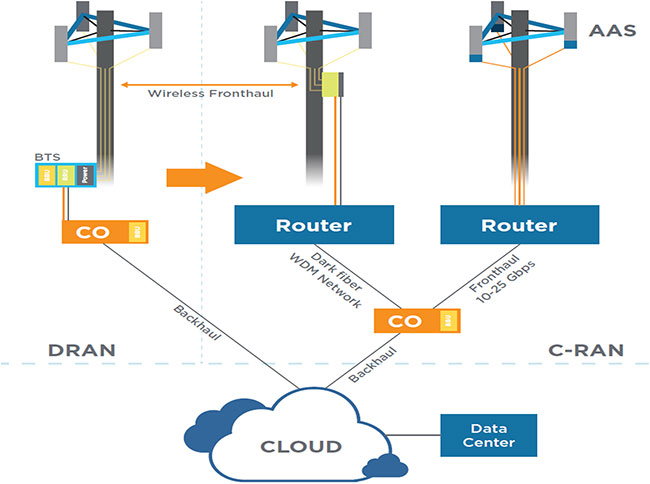How to simplify 5G baseband unit design using high speed connectors
A baseband unit (BBU) is a device in a telecommunications network that processes baseband signals. The BBU acts as the centralised “hub” of the base station, processing uplink and downlink data traffic and controlling RRU (remote radio units) functionality via optical fiber.
RAN consists of the baseband processing unit and the RF processing unit. Transceivers, analog - to - digital converters (ADC), power amplification (PA), and filtering processors comprise the RRU system. The signals arriving from the RRU are converted to electrical signals at the BBU and after adjusting for the baseband frequencies, are further transported to the core network. Transponders are interconnected units that are related with the RRU or the BBU and play an important role in the transmission of 5G signals.
With the 5G new radio standard (NR), the key components may combine the RRUs and the antennas into an AAS (Active antenna system). The Cloud RAN (C-RAN), as depicted in the figure below, is an innovative network solution for 5G wireless communication. However, by centralising the BBUs at a C-RAN hub, a new layer known as fronthaul is introduced into the network. It serves as a connection between the BBU pool and the remote radio heads at the cell site or small cell location. Backhaul and transport network will likely need to be upgraded to support increasing traffic requirements for high-speed optical connectivity.

Figure: 5G Architectures and connections with BBU
5G will require a tremendous increase in the number of base stations, since the eMBB (enhanced Mobile Broadband) portion of 5G would be using a much-higher-frequency spectrum. Massive MIMO and AAS (Active Antenna System) necessitate a more complicated design. They also necessitate further component miniaturisation and high-speed interconnections within the AAS. The radio unit's components should be qualified for signal integrity (SI), electromagnetic interference (EMI), and thermal performance. Antennas and RRUs precisely gather up high-speed RF wave signals from cell phones and IoT devices using advanced MIMO and Beamforming techniques before converting them to fibre optic signals for further processing.
With increasing carrier frequency, both path loss and diffraction loss become more severe, and the atmospheric effects must be considered. To achieve higher speeds and lower latency, massive increases in capacity are required, which necessitate the use of a large amount of spectrum. To minimise impedance differences throughout the transmission line, connectors must be properly designed and manufactured. Otherwise, signals may be reflected and result in degraded performance. External signals might potentially be harmful. As a result, connectors must properly protect the system and prevent external signals from being affected by electromagnetic interference and capacitive pickup, which becomes exceedingly challenging at higher speeds.
Right connectivity solution for BBU:
High speed I/O connectors play an important role in the transponders and routers that ensure the seamless operation of the 5G transport. RF Connectors, I/O Solutions, Magnetic Jacks, and Memory Sockets are instances of BBU components. Outdoor I/O connectors are known for their great durability and performance, ensuring high power delivery with 125A per contact, IP67 compliance, and field installable. Many I/O high-speed connectors adopt a system that is based on a standard messaging protocol that defines the mechanical and electrical interface.
The interconnect contact design provides improved mechanical durability, flexibility and scalability. The design's resonance dampening characteristics allow for enhanced signal integrity performance. High-speed I/O cages and connectors are intended to aid in the provision of high-speed I/O connections for AAS, baseband units and edge cloud infrastructure systems. Small cells will play a significant role in the 5G era, they will increase the density of the network and bring short-range solutions, potentially utilising both sub-6 GHz and mmWave technology.
Connectors including SFP, microQSFP, QSFP, QSFP+, Flash connector, Z-Link, Cool Edge connector, SAS connector, XFP, CFP2, and FullAXS Mini connectors will provide small size and scalability needed to design fibrer, power, and signal connectivity for rugged environments. FullAXS interconnects can be placed almost anywhere on the box/enclosure due to their flexible sealing system. These connectors are ruggedised, robust, and easy to install outside, and they can adapt to power, fiber, and copper cable, providing higher power in smaller form factors and supporting board-to-board and cable-to-board applications. They are very durable at IP68 level for a broad range of 5G applications.






